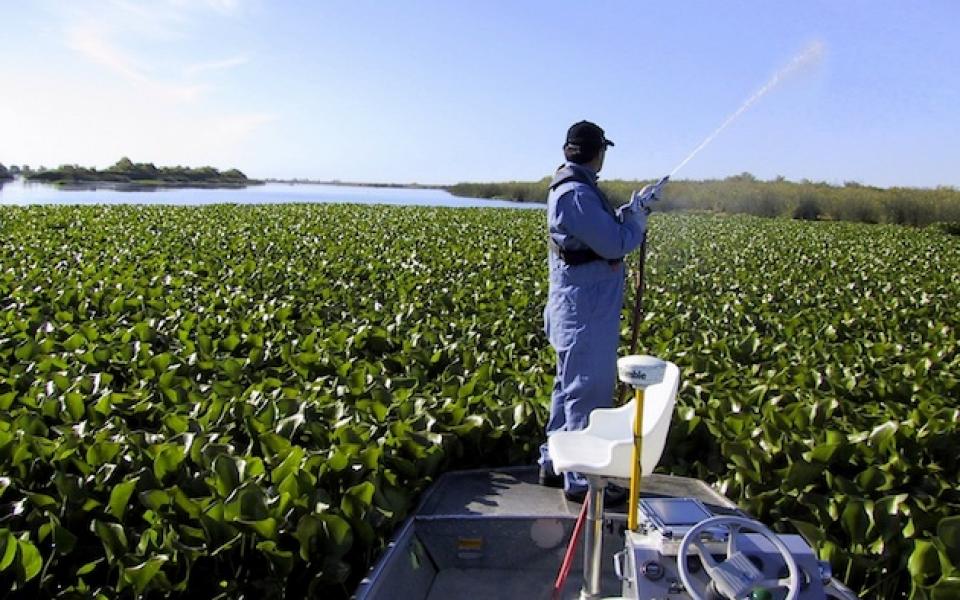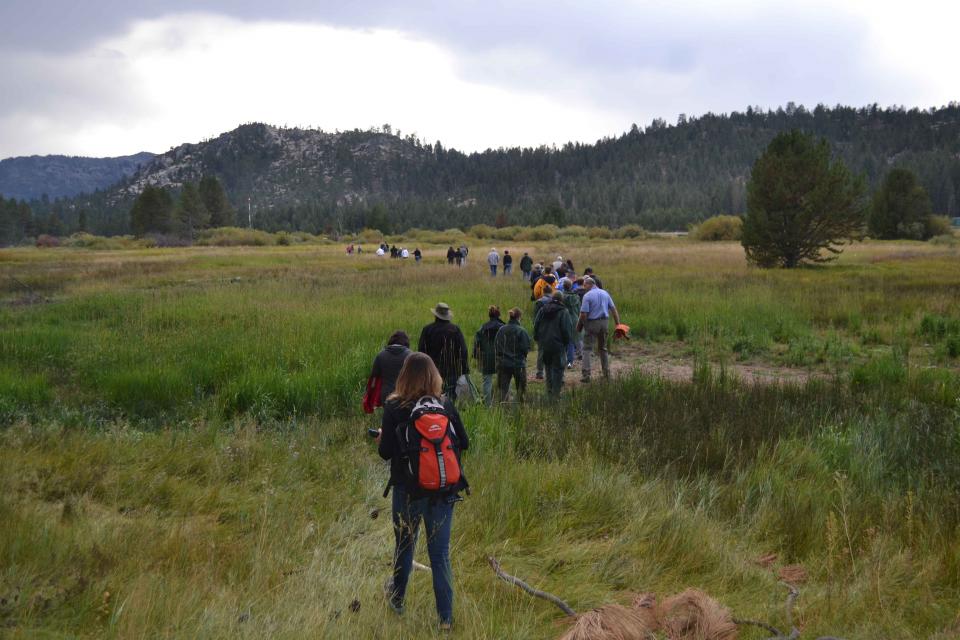It’s Not Just Nutria — Sacramento-San Joaquin Delta has 185 Invasive Species, But Tracking Them is Uneven
Dear Western Water readers:
 For more than 100 years, invasive
species have made the Sacramento-San Joaquin Delta their home,
disrupting the ecosystem and costing millions of dollars annually
in remediation.
For more than 100 years, invasive
species have made the Sacramento-San Joaquin Delta their home,
disrupting the ecosystem and costing millions of dollars annually
in remediation.
The latest invader is the nutria, a large rodent native to South America that causes concern because of its propensity to devour every bit of vegetation in sight and destabilize levees by burrowing into them. Wildlife officials are trapping the animal and trying to learn the extent of its infestation.
Even though invasive plants and animals long have been known to exist in California’s water hub, tracking their extent in an area as large as the Delta — 738,000 acres — is an uneven task that could benefit from greater coordination and funding, a panel of experts recently told the Delta Independent Science Board.
Western Water writer Gary Pitzer takes a look at the challenges and the hopes for improvements. Read the full story here.
On the Road: Cosumnes River Preserve offers visitors a peek at what the historic Central Valley once looked like
 Deep, throaty cadenced calls —
sounding like an off-key bassoon — echo over the grasslands,
farmers’ fields and wetlands starting in late September of each
year. They mark the annual return of sandhill cranes to the
Cosumnes River Preserve, 46,000 acres located 20 miles south of
Sacramento, along the eastern edge of the Sacramento-San Joaquin
Delta.
Deep, throaty cadenced calls —
sounding like an off-key bassoon — echo over the grasslands,
farmers’ fields and wetlands starting in late September of each
year. They mark the annual return of sandhill cranes to the
Cosumnes River Preserve, 46,000 acres located 20 miles south of
Sacramento, along the eastern edge of the Sacramento-San Joaquin
Delta.
The Cosumnes River is said to be the last free-flowing river from the Sierra Nevada to the Central Valley, and offers visitors a chance to peek at what the Central Valley once looked like. The preserve is home to more than 250 bird species, more than 40 fish species, and 230 plant species, including small but significant stands of valley oaks that were once ubiquitous across the Central Valley. Birds that migrate throughout the Pacific Flyway make the preserve a stop on their journey.
Read more about the Cosumnes River Preserve here.
Water Around the West
Here are five don’t-miss articles from the last week:
New Restoration Effort Would Give Big Boost to Lake Tahoe Watershed. Water Deeply’s Tara Lohan talks with Nicole Cartwright of the Tahoe Resource Conservation District about the acquisition of a large tract of land along the Upper Truckee River and what it could mean for improving Lake Tahoe’s prized clarity.
Like It Or Not, the Water Is Coming: Will the Bay Area Defend Against Rising Seas, or Embrace Them? Molly Peterson, writing for KQED in San Francisco, takes a look at how rising sea levels could affect San Francisco Bay Area communities, what some of the communities are doing to respond, and how those responses could make things worse elsewhere.
Price of Water 2018: Utilities Revise Household Water Rate Formulas. Brett Walton with Circle of Blue examines how America’s large cities are forging ahead with fresh spending to modernize their water delivery systems. One result is that all the work to repair municipal water systems is raising the cost of service, especially in places like California.
YCWA contributes $1.5M to forest management pilot project. Jake Abbott with the Appeal-Democrat in Marysville reports on why the Yuba County Water Agency is contributing $1.5 million to a $4.6 million pilot project in the North Yuba Watershed focused on forest health that could help reduce the risk of wildfire from dead or dying trees and improve water content and quality.
Warming Waters Push Fish To Cooler Climes, Out Of Some Fishermen’s Reach. NPR’s Christopher Joyce takes a look at how the oceans are getting warmer and fish are noticing. Many that live along U.S. coastlines are moving to cooler water. New research predicts that will continue, with potentially serious consequences for the fishing industry.
Water Word
 Water Word of the Day: Invasive
species. California’s waterways are home to some of
the densest concentrations of invasive species in the world.
Invasive species threats have included trout and bass in Lake
Tahoe, water hyacinth in the Sacramento-San Joaquin Delta, zebra
and quagga mussels in Southern California, and tamarisk and salt
cedar that erode beaches and degrade wildlife habitat along the
Colorado River. Read more about the spread of invasive species in
Aquapedia, our free, online water
encyclopedia.
Water Word of the Day: Invasive
species. California’s waterways are home to some of
the densest concentrations of invasive species in the world.
Invasive species threats have included trout and bass in Lake
Tahoe, water hyacinth in the Sacramento-San Joaquin Delta, zebra
and quagga mussels in Southern California, and tamarisk and salt
cedar that erode beaches and degrade wildlife habitat along the
Colorado River. Read more about the spread of invasive species in
Aquapedia, our free, online water
encyclopedia.
At the Foundation
 The Sierra Nevada mountains, which
are key to California’s water supply through snowmelt, are dotted
with nearly 130 million dead trees weakened by drought and insect
infestations. The severe tree mortality has increased the risk of
devastating wildfires, reduced the ability of forests to absorb
greenhouse gases and limited the effectiveness of forests and
meadows to regulate water quality and moderate downhill flow. On
our Headwaters Tour, June
28-29, guests will hear from leading forest managers and
entomologists about the extent of this epidemic, how it is
altering forests and affecting upper watersheds, and what can be
done to mitigate the damages. Here’s how you can join the
tour.
The Sierra Nevada mountains, which
are key to California’s water supply through snowmelt, are dotted
with nearly 130 million dead trees weakened by drought and insect
infestations. The severe tree mortality has increased the risk of
devastating wildfires, reduced the ability of forests to absorb
greenhouse gases and limited the effectiveness of forests and
meadows to regulate water quality and moderate downhill flow. On
our Headwaters Tour, June
28-29, guests will hear from leading forest managers and
entomologists about the extent of this epidemic, how it is
altering forests and affecting upper watersheds, and what can be
done to mitigate the damages. Here’s how you can join the
tour.
Water Academy
 Want to learn more about invasive
plants and animals and how they can alter the natural ecosystem?
Take a look at our bundled pair of posters — Space Invaders and
Unwelcome Visitors. Each poster, suitable for framing, explains
how nonnative plants and animals can lead to the demise of native
plants and animals. Here’s how to order
yours.
Want to learn more about invasive
plants and animals and how they can alter the natural ecosystem?
Take a look at our bundled pair of posters — Space Invaders and
Unwelcome Visitors. Each poster, suitable for framing, explains
how nonnative plants and animals can lead to the demise of native
plants and animals. Here’s how to order
yours.








